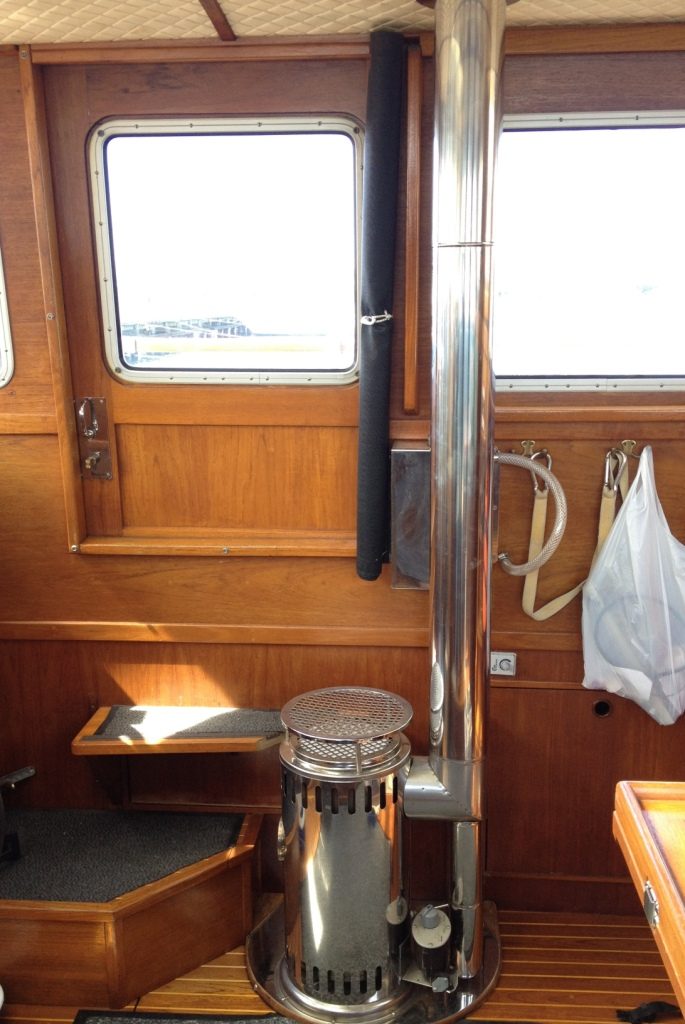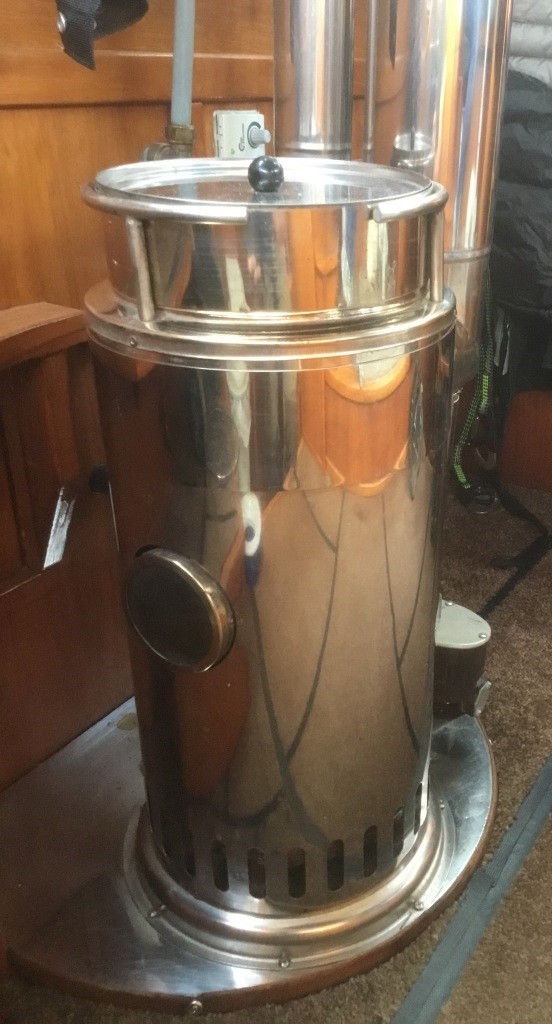Oil stove

To heat the boat, we use a stove from Refleks (model 2000 kv, which emits a maximum of 4.2 kW divided between air and hot water for radiators).
The oil stove takes the air for combustion from the wheel house, which provides good dry air. Depending on the outside temperature, the humidity in the cabin is between 30 and 40% relative humidity.
The stove runs on diesel fuel from the boat’s fuel tank and supplies heat and hot water (antifreeze) to radiators.

After having got some further development, we are extremely satisfied with the stove.
Cooling the chimney pipe
Made as an extra order from Refleks
With the help of a fan, the chimney pipe is forcibly cooled with air taken from outside. The heated air is sent out into the bathroom. Result: warm and dry bathroom, less heat release to the room the stove is in, and less heat release to the house sparrows.

“Duvet” for the stove
Made as an extra order from Reflex
The selected stove gives approx. 1/3 of the heat to the room, where it is placed (wheelhouse), and 2/3 of the heat is delivered as hot water, which is sent out in radiators to the rest of the ship.
We both have had made an insulated lid to put over the hob and a “belly belt” to cover the upper cooling holes.

By regulating: from no “duvet and belly belt” and belt to full “duvet and belly belt”, we can regulate the heat release in the wheelhouse from wind at night to calm and sunshine during the day.
Elpatron i radiatorvandet
When the outside temperature is above about 10 degrees, the stove produces too much heat, therefore in the radiator water we have installed an electric heater, which is regulated from a thermostat.
The electric heater is made by Alde, and probably mostly intended for caravans, but works just as well for a boat.
Varmeveksler til motoren
Oil stoves, which, like ours, draw the combustion air from the cabin, are unsuitable for use while sailing, as it easily happens that the air flow reverses and the smoke ends up in the cabin. We therefore have inserted a heat exchanger between the cooling water from the main engine and the radiator water (of course with a shut-off tap, so that the cooling water does not heat up in port). It works really well and quickly provides lots of heat .
Ekstra brænder til fyret
Made of reflex as a service repair
We had problems getting the stove to burn quietly and cleanly at high heat output. The problem was solved with a larger burner for high output use. The problem is probably chimney dependent.
Ekstra cirkulation af vandet i kedlen
Made of reflex as a service repair
We have had the problem, that the water inside the stove started to boil at high output without releasing much heat to the rest of the water. The problem was solved with a small pipe that improved circulation in the boiler.
Most boilers have a spiral pipe instead of a boiler, so of course they do not have the above problem, but if you choose the 2000kv model and must have a high flow temperature on the radiator water, it is a good idea to have this pipe inserted immediately.
Other things about the installation of the stove
As a circulation pump, we use an energy-efficient circulation pump from an ordinary house oil boiler. It uses approx. 5W (220V), if we don’t have shore power, it is supplied from an inverter. Unlike 12V pumps, it is long-lasting.
When I installed the radiator system, I inserted shut-off taps, both for all strings, and for two extra strings. One set of extra taps is used for the heat exchanger for the engine, the other set is used for an extra radiator in the kitchen. I have been really happy with the taps on the other strings when changes/repairs had to be made, without them I would have had to empty the water/antifreeze pipes several times.
Links to suppliers:
